Important Facts about the Invention of the Reailroad
U.S. Railroad History: A Timeline
Railroad history in the United States is nearly as old as the country itself, dating back to the mid-1820s. As we know, this great nation would not have grown and prospered as it did without the railroads, which brought together the young country and allowed for unprecedented prosperity.
The "Golden Age" lasted from roughly the 1880s until the 1920s, at which time other modes (automobiles and airplanes) slowly eroded the railroads' transportation monopoly.
In addition, stifling government regulation beginning in the early 20th century eventually choked them to the point of desperation.
Unable to set their own freight rates, abandon unprofitable routes, or rid themselves of money-losing passenger trains many were on the brink of collapse by the 1970s; names like the Penn Central, Rock Island, Milwaukee Road, Reading, Jersey Central, and others.
Following deregulation in 1980 the industry made a comeback and today is witnessing a renaissance. In this section we will look at the history of our country's involvement with trains from its earliest beginnings in the 1820s through today.
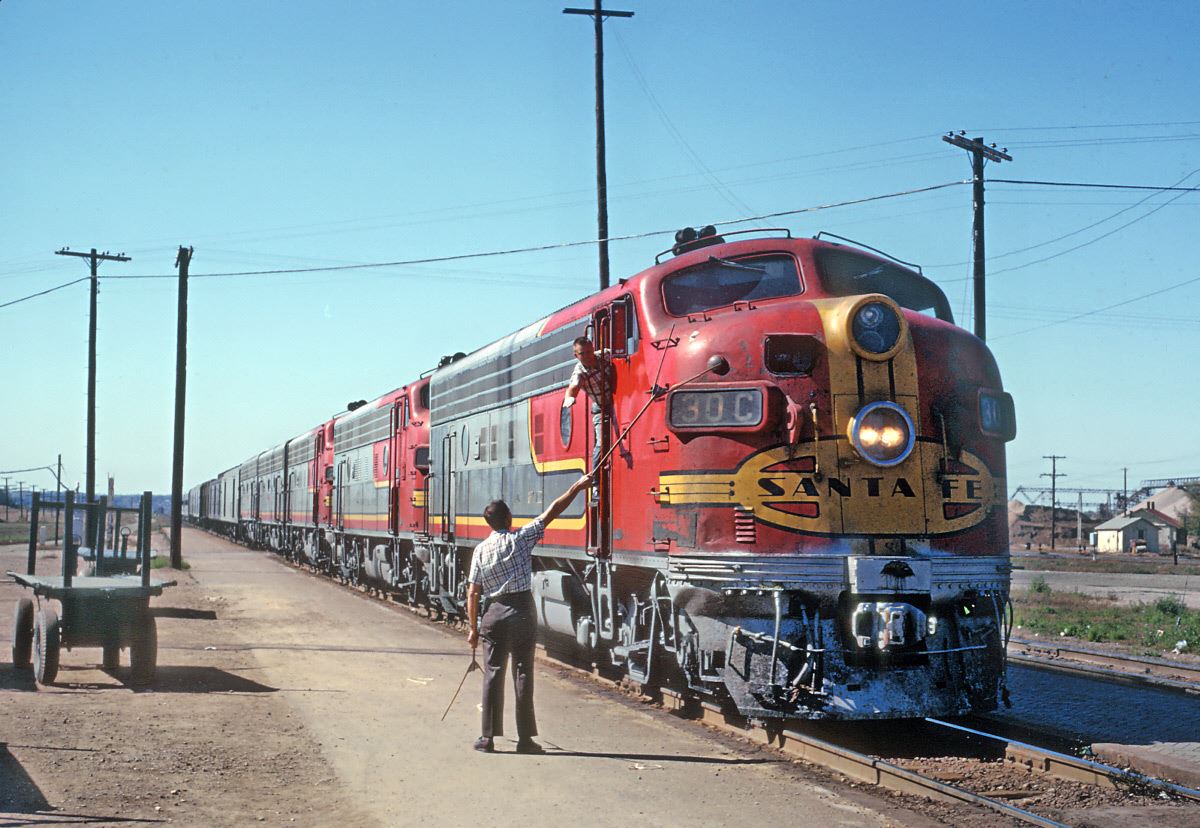 A Santa Fe crewman is about to grab orders from F3A #30-C as the "Grand Canyon" arrives at Chillicothe, Illinois on October 7, 1966. Roger Puta photo.
A Santa Fe crewman is about to grab orders from F3A #30-C as the "Grand Canyon" arrives at Chillicothe, Illinois on October 7, 1966. Roger Puta photo.
A Brief History
Railroads in America can be traced back to 1815 when Colonel John Stevens gained the first charter in North America to build the New Jersey Railroad Company, although it was not constructed until 1832.
The NJRR later went on to become part of the Pennsylvania Railroad's far-reaching network. Colonel Stevens also tested the first type of steam locomotive in 1826, when he showcased his "Steam Waggon" (basically a steam-powered horse carriage) on a small circular track he had built at his estate in Hoboken, New Jersey.
Later, in August of 1829 Horatio Allen, a chief engineer for the Delaware & Hudson Canal Company (which went on to become the Delaware & Hudson Railway) tested an early English steam locomotive on a 16-mile stretch of company-owned track between Honesdale and Carbondale, Pennsylvania.
The locomotive was named theStourbridge Lion, a very simple two-axle machine with a vertical boiler. It, along with three other similar designs, was envisioned to handle coal from the D&H mines at Carbondale to Honesdale.
Alas, only the Lion was ever tested and ultimately proved too heavy for the track, spending most of its time stored away in a shed.
Railroad Timeline, A Snapshot Of The Past
19th Century
Railroads In The 1820s/1830s: History, Photos And Maps
Railroads In The 1840s: History, Background And Photos
Railroads In The 1850s: Photos, History And Statistics
Railroads And The Civil War: Statistics, Photos, Maps And More
Great Locomotive Chase Of 1862 (Civil War)
Transcontinental Railroad: History, Maps, And Photos
Railroads In The 1870s: Photos, History, And Statistics
The Great Railroad Strike Of 1877: History, Background, And Statistics
First Aid Kit, An Overview
Railroads In The 1880s: Photos, History, And Statistics
Railroads In The 1890s: History, Statistics, Photos
20th Century
Railroads In 1900-1910: Statistics, Photos, History
Railroads During 1910-1920: History, Background, Photos
Railroads During World War I: Statistics, Photos, History
United States Railroad Administration: History, Background, And Purpose
Streamliners And The 1930s: Photos, History, Background
Railroads In World War II, The 1940s
The Industry In Decline, The 1950s: History, Photos, And More
Mergers And Bankruptcies, Railroads During The 1960s And 1970s: History, Photos, Statistics
21st Century
Railroads Of Today, The 1980s Onward: Photos, History, And Statistics
Official Guide Of The Railways (PDF's)
A year later, in August of 1830, the three year old Baltimore & Ohio carried out trials of theTom Thumb , the work of Peter Cooper. A month after this event the South Carolina Canal & Railroad Company (SCC&RR) tested its Best Friend of Charleston.
The SCC&RR would also be remembered as the first to haul a revenue train with an American-built design when itsBest Friend of Charleston, a product of the West Point Foundry in New York, carried paying customers on December 25, 1830.
While the steam locomotive had proven its worth on the South Carolina road the B&O is recognized as our nation's first common carrier (a corporate entity which is expected to haul anything, within reason, offered to it by the general public).
The railroad was chartered on April 24, 1827 to solidify Baltimore's standing as one of America's important ports and provide competition against New York's Erie Canal.
Shortly after B&O's creation merchants in Charleston, South Carolina chartered the aforementioned South Carolina Canal & Railroad Company intended to link Charleston with Hamburg (along the Savannah River).
As the success of these operations, and others, grew railroad mania struck the nation. The new form of transportation could operate in all types of weather and move people and goods at previously unheard of speeds.
Notable Early Railroads
Granite Railway, Our Country's First Railroad
Delaware & Hudson, First Use Of Steam In U.S.
Baltimore & Ohio, First Common-Carrier
Camden & Amboy, New Jersey's First Chartered Railroad
Mohawk & Hudson Railroad
South Carolina Canal & Rail Road Company
By 1840, states east of the Mississippi River boasted over 2,800 miles of track and a decade later that number had more than tripled to over 9,000. During these early years much of the trackage was still disconnected and largely concentrated in the Northeast.
There were also a variety of different gauges in service, ranging from 4 feet 8 1/2 inches (which later became standard) to six feet.
Unfortunately, traveling could be a tricky, proposition as railroads saw no need to develop safe operations. Even after development of modern "T"-rail, old strap-iron rail was still used for many years.
 A Santa Fe company photo featuring a beautiful lineup of FT's sitting outside the shops at Barstow, California circa late 1940s. Author's collection.
A Santa Fe company photo featuring a beautiful lineup of FT's sitting outside the shops at Barstow, California circa late 1940s. Author's collection.
This led to cases of deadly "snake heads" where iron straps came loose from their attached wooden planks and tore into the under-frame of cars, injuring or killing passengers. In addition, cars themselves were not reinforced to better withstand the carnage during derailments.
Railroads used their power to influence politicians and avoid infrastructure improvement and safety enhancements, such as knuckle-couplers and air brakes. Such things only cost money.
In their greed they even refused to interchange freight with one another. This arrogant attitude eventually led to extreme regulatory oversight.
Who Invented The Railroad?
Who invented the railroad? As mentioned elsewhere in this article, the first chartered railroad in the United States was the New Jersey Railroad Company of 1815 while the Granite Railway was the first actually put into service in 1826.
However, railroading's roots can be traced back centuries before the modern incarnation was born during the 19th century. As with many of our contemporary transportation technologies, the railroad came about gradually over time.
Many different individuals are recognized for developing a number of different devices which found their way into what would now be described as the modern-day railroad of the 1820's.
According to historian Mike Del Vecchio's book, "Railroads Across America," the very first railroad-like operation was opened in England during 1630 which used wooden rails, with wooden cross-ties (or "sleepers") for lateral support, to haul coal.
The first known implementation of iron rails occurred at Whitehaven, Cumberland in 1740, followed by William Jessop's (Loughborough, Leicestershire) invention of the flanged wheel in 1789. The steam engine is attributed to Thomas Newcomen who received a patent for his design in 1705.
It was later improved upon by James Watt in 1769 who realized expanding steam was much more powerful and efficient than Newcomen's condensing version. He first employed the engine in steamboats, which later made their way to the United States.
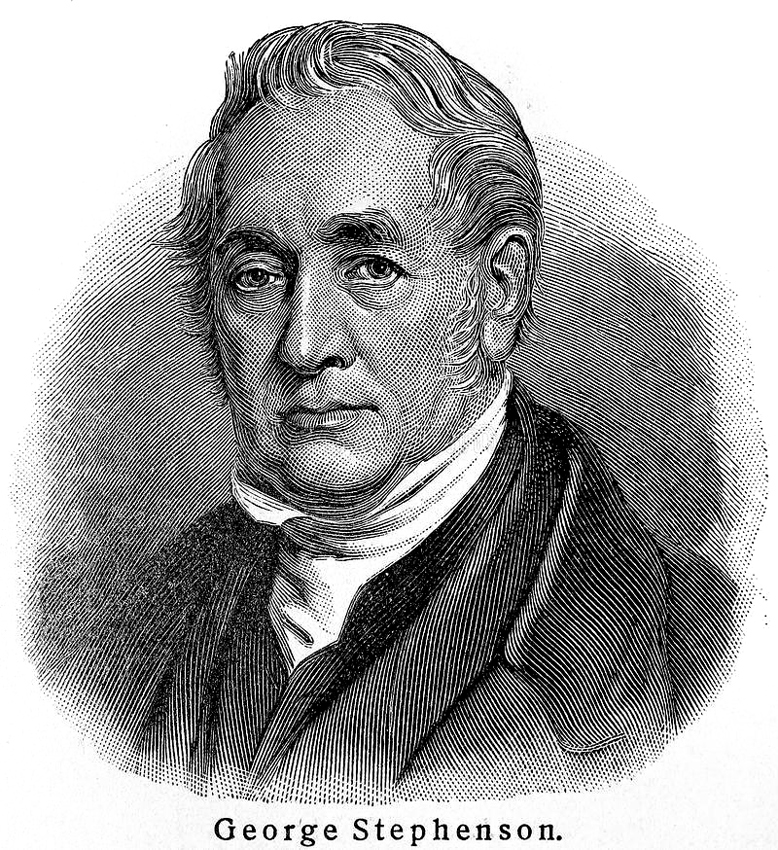 George Stephenson is credited as inventor the modern railroad when the Stockton & Darlington was placed into service in 1825.
George Stephenson is credited as inventor the modern railroad when the Stockton & Darlington was placed into service in 1825.
Before Colonel John Stevens tested his "Steam Waggon" in 1826, the first patent for a steam locomotive is credited to Englishmen Richard Trevithick and Andrew Vivian in 1802.
It entered service in 1804 along the Merthyr-Tydfil Railway in South Whales where it pulled loads of iron ore along a tramway. Two decades would pass before the first modern version appeared, the work of George Stephenson.
Although often overlooked, the very first device which could be described as a "locomotive" was the work of a Frenchman, Nicolas-Joseph Cugnot, in 1769. It was steam-powered but did not run along a fixed trackway.
Today, this historic piece of engineering still survives, housed and on display at the Musée des Arts et Métiers in Paris. All modern locomotives and automobiles can trace their heritage back to this machine.
Once more, Britain earns the recognition as putting the first contemporary railroad into operation when the Stockton & Darlington Railway formally opened on September 27, 1825.
Mr. George Stephenson, a well-known builder of early steam locomotives, was also heavily involved in this project: he surveyed the route, gauged the rails to 4 feet, 8 inches (only a 1/2-inch narrower from the width which would later be recognized worldwide as standard-gauge); and, of course, furnished the locomotives.
His little 0-4-0, namedActive (later renamedLocomotion No. 1) was placed into service that day, earning Stephenson recognition as creator of the modern railroad. His designs would also find their way onto early U.S. railroads until American builders became well-established.
For their many advantages, some in public simply did not like the iron horse. As John Stover points out in his book, "The Routledge Historical Atlas Of The American Railroads," one school board in Ohio described them as a "device of the devil" while those overseeing the Massachusetts turnpike called them "cruel turnpike killers" and "despisers of horseflesh."
There was even a claim that rail travel would cause a "concussion of the brain." Despite corporate malfeasance and the public's weariness, the efficiency and speed trains offered could simply not be argued.
 Chicago Great Western F3A #115-A has freight #43 along the main line at Kenyon, Minnesota (roughly 50 miles south of the Twin Cities) on August 31, 1962. Roger Puta photo.
Chicago Great Western F3A #115-A has freight #43 along the main line at Kenyon, Minnesota (roughly 50 miles south of the Twin Cities) on August 31, 1962. Roger Puta photo.
During the Civil War railroads once more proved their worth as they quickly transported men and material to the front lines at speeds not previously possible.
The North effectively harnessed this advantage, as historian John P. Hankey points out in his article, "The Railroad War: How The Iron Road Changed The American Civil War," from the March, 2011 issue of Trains Magazine.
Its ability to do so was predominantly why it won the war. Before hostilities had ended efforts were already underway to link the entire continent by rail.
With the creation of the Pacific Railway Act, signed into law by President Abraham Lincoln on July 1, 1862, authorizing construction of the Transcontinental Railroad.
The new legislation formed the Union Pacific Railroad to build west from the Missouri River at Omaha, Nebraska while the Central Pacific struck out eastward from Sacramento, California. Both companies were given large tracts of land to complete their respective sections.
 Small-town America... Santa Fe F7A #335 is southbound with a maintenance-of-way (MOW), weed-spraying train as it passes through the little hamlet of Glen Flora, Texas on the now-abandoned Cane Belt Branch during June of 1976. Gary Morris photo.
Small-town America... Santa Fe F7A #335 is southbound with a maintenance-of-way (MOW), weed-spraying train as it passes through the little hamlet of Glen Flora, Texas on the now-abandoned Cane Belt Branch during June of 1976. Gary Morris photo.
After several years of hard work, particularly for the Central Pacific, the two met at Promontory Point, Utah during a formal ceremony held on May 10, 1869.
Without the Pacific Railway Act our country's history would likely be very different as rail travel opened the west to new economic opportunities.
After the Transcontinental Railroad's completion the industry exploded; by the 1890s there were more than 163,000 miles in operation.
Eventually, four major railroads established direct lines from the Midwest to West Coast including the Great Northern, Northern Pacific, Santa Fe, and Chicago, Milwaukee, St. Paul & Pacific (Milwaukee Road) while others worked together in linking both points.
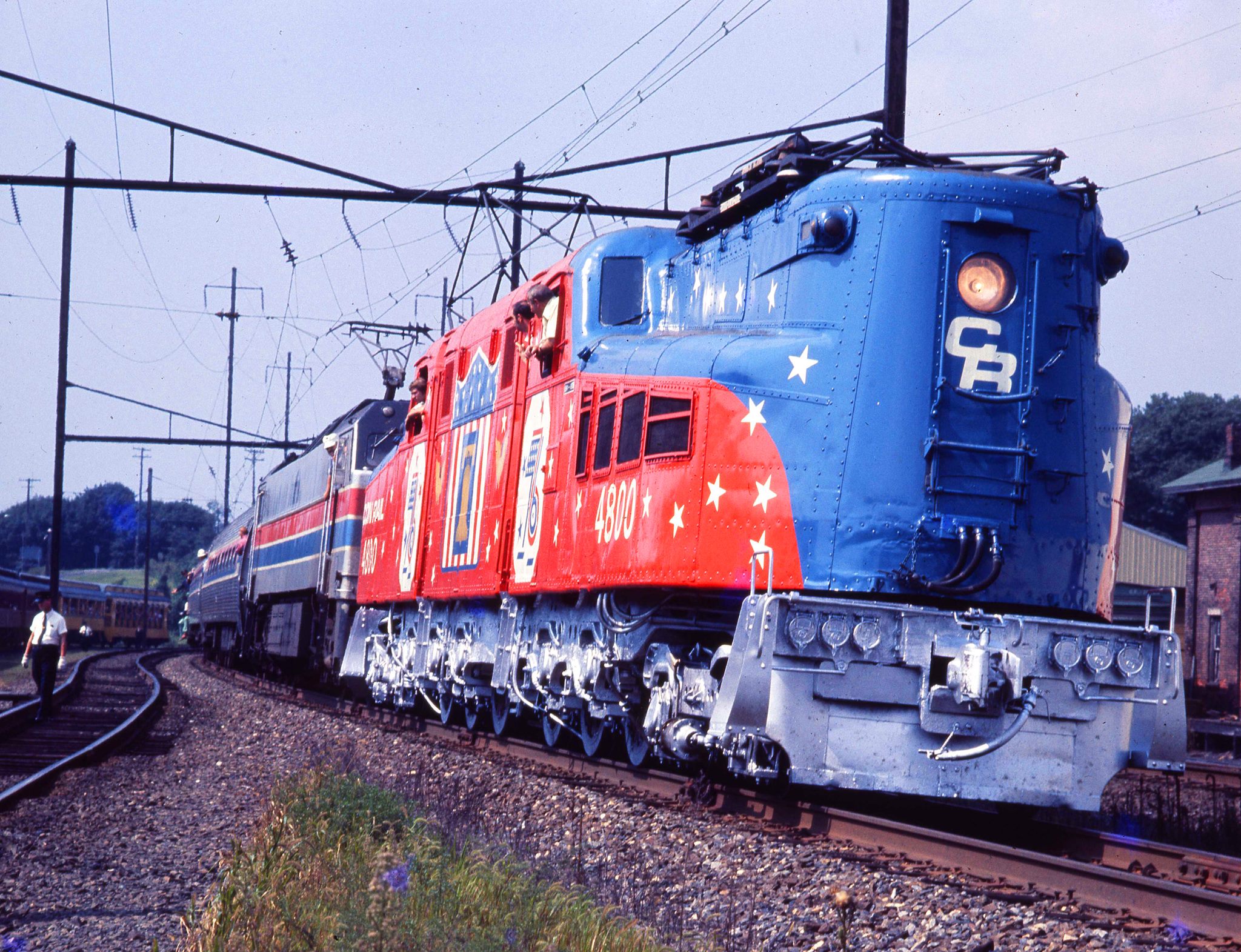 Conrail GG-1 #4800 ("Old Rivets," the original GG-1), in its vibrant Bicentennial livery, stopped at Leaman Place, Pennsylvania at the interchange with the Strasburg Railroad. Jerry Custer photo.
Conrail GG-1 #4800 ("Old Rivets," the original GG-1), in its vibrant Bicentennial livery, stopped at Leaman Place, Pennsylvania at the interchange with the Strasburg Railroad. Jerry Custer photo.
The era also saw many other advances as the late historian Jim Boyd notes in his book, "The American Freight Train." After several years of distrust a standard track gauge of 4 feet, 8 1/2 inches was adopted during the 1880s along with development of the automatic coupler and air brake.
All three initiatives proved revolutionary, allowing for greater efficiency and much safer operations. From the late 19th century though the 1920's railroads enjoyed their greatest dominance and profitability; in particular was the year 1916, which saw mileage peak at over 254,000 and railroads carried virtually 100% of all interstate traffic.
Rail Mileage Throughout The Years
Below is a timeline of railroad mileage throughout the years:
1840: 2,808 Miles
1850: 9,021 Miles
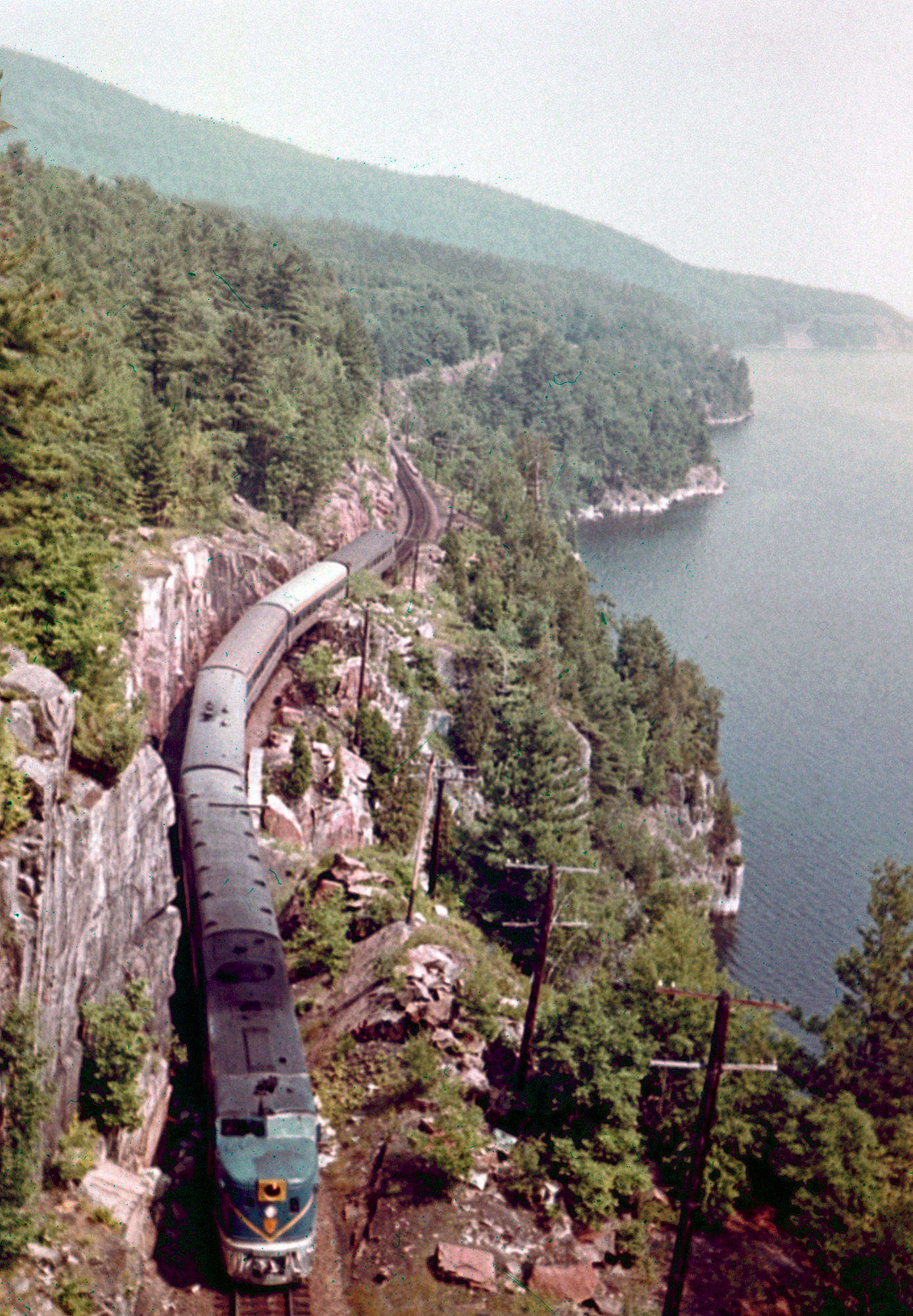 Delaware & Hudson's southbound "Laurentian" hugs the red rocks along Lake Champlain during the late 1960's. Jim Shaughnessy photo. Author's collection.
Delaware & Hudson's southbound "Laurentian" hugs the red rocks along Lake Champlain during the late 1960's. Jim Shaughnessy photo. Author's collection.
1860: 30,000+ Miles
1870: 52,922 Miles
1880: 93,267 Miles
1890: 163,597 Miles
1900: 193,346 Miles
1916: 254,037 Miles (Peak Mileage)
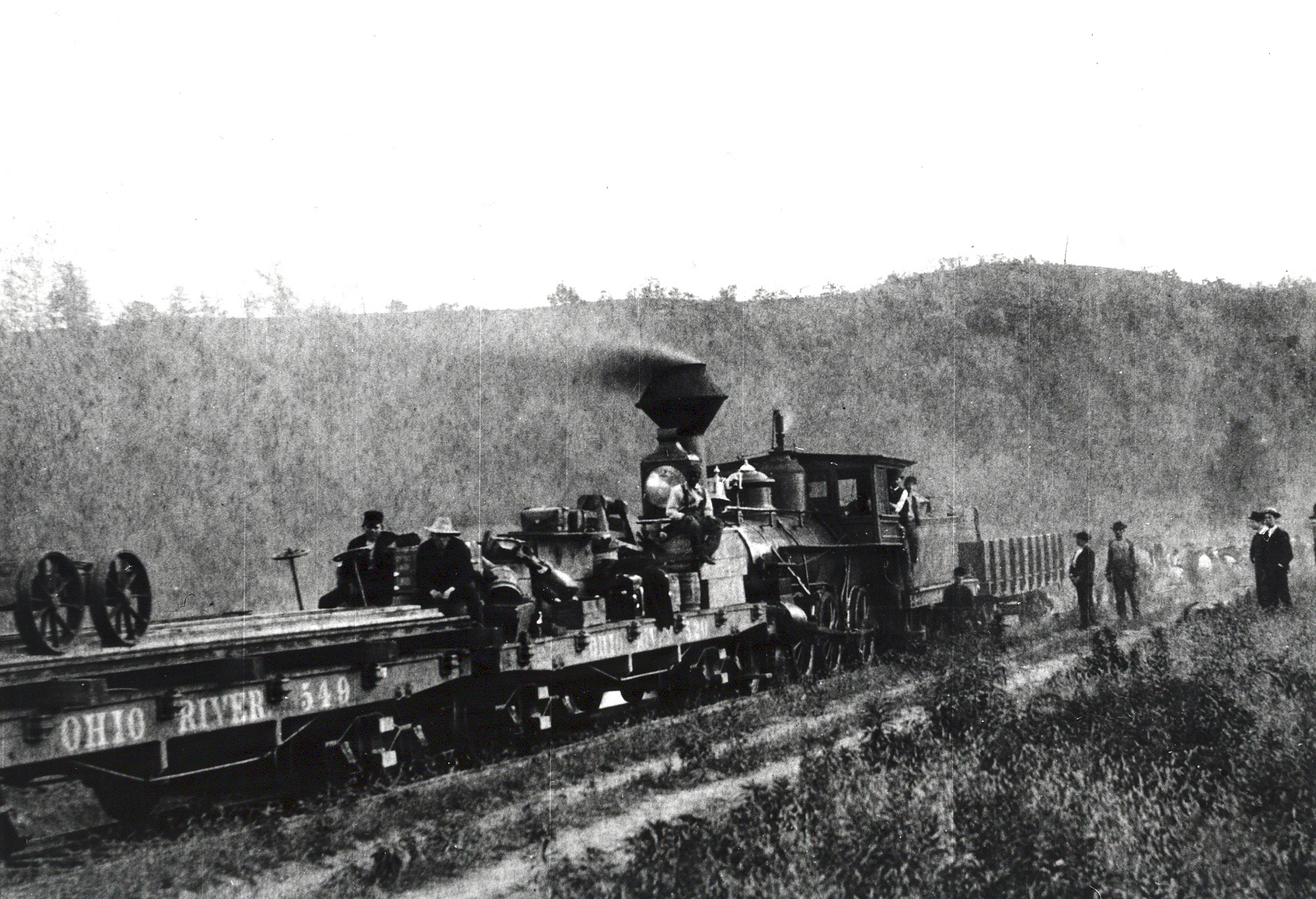 An Ohio River Rail Road 4-6-0 leads a work train near Parkersburg, West Virginia during the line's construction circa 1884. Author's collection.
An Ohio River Rail Road 4-6-0 leads a work train near Parkersburg, West Virginia during the line's construction circa 1884. Author's collection.
1945: 226,696 Miles
1963: 214,387 Miles
1995: 170,000+ Miles
Today: 138,477 Miles
Sources: "The Routledge Historical Atlas Of The American Railroads," by John F. Stover. New York: Routledge, 1999. Federal Railroad Administration's "Summary Of Class II and Class III Railroad Capital Needs And Funding Source" Report (October, 2014)
During the 1930s the streamliner era hit the nation, all in an attempt to sway patrons back to the rails. These fast, sleek new machines provided a new perk; color and modernity never before seen.
The industry's transportation dominance ended after World War II, as a long decline followed thereafter. In response, the so-called mega-merger movement was launched in the 1950s in an attempt to cut costs through consolidation.
At the time the move was only partially successful as railroads slipped into despair by the 1970's.
The common observer could see this for themselves as tracks became weed-choked while trains were dilapidated. For carriers like the Rock Island and Penn Central, both on the verge of complete shutdown, dirty and barely operational equipment was not uncommon.
What happened in the 1970's has many causes although it can arguably be traced back to expanded powers placed upon the Interstate Commerce Commission following the passage of the Elkins Act (1903) and, in particular, the Hepburn Act (1906) and Mann-Elkins Act (1910).
The latter two legislative actions gave ICC the authority to set freight rates and force railroads to explain why any rate change should be implemented.
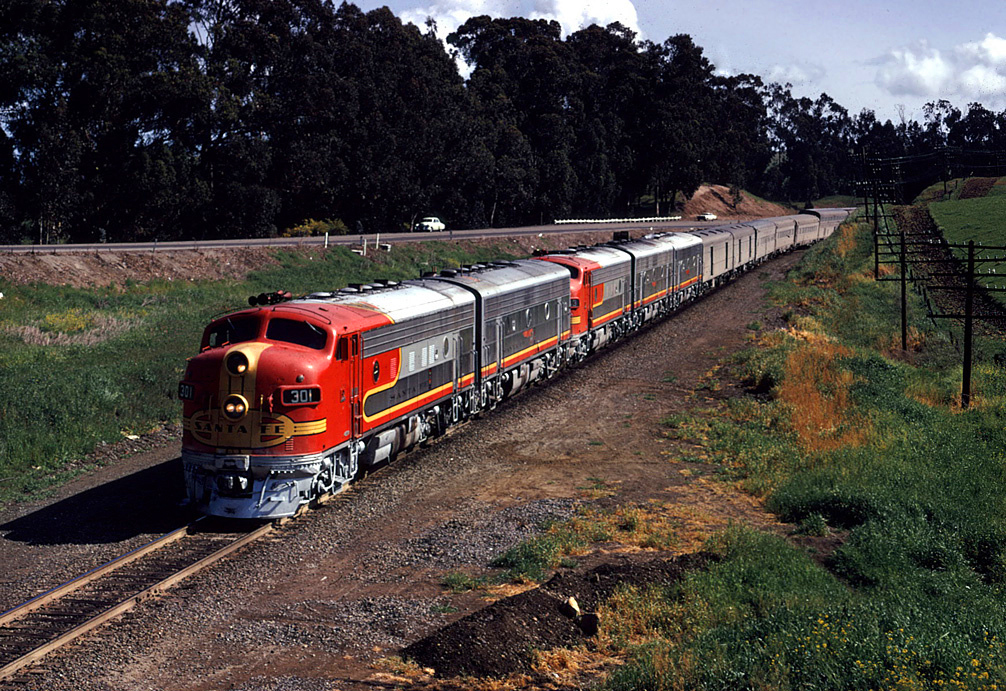 An A-B-A-B-B set of Santa Fe covered wagons, led by F7A #301, pulls the westbound San Francisco Chief during one of its final runs through Hercules, California in April of 1971. Amtrak was only a few days away. Drew Jacksich photo.
An A-B-A-B-B set of Santa Fe covered wagons, led by F7A #301, pulls the westbound San Francisco Chief during one of its final runs through Hercules, California in April of 1971. Amtrak was only a few days away. Drew Jacksich photo.
It was a lengthy, time-consuming process that was rarely successful. The expanded federal oversight was all brought about to limit railroads' power as many executives had grown arrogant and forgetful of their ultimate purpose, to serve the public interest.
Unfortunately, the legislation went too far and had placed an increasing burden on the industry by the post-World War II period, at which point they no longer held a transportation monopoly.
During the 1970s several famous companies went under, now termed fondly as "fallen flags." The decade also saw the collapse of Northeastern rail service following Penn Central's 1970 bankruptcy.
Its failure led to others as neighboring railroads filed for reorganization. What eventually came out of the mess was the Consolidated Rail Corporation.
A federally-funded corporation to restore service, Conrail began on April 1, 1976. A few years earlier, also partially in response to PC's downfall, another government-sponsored railroad was born, the National Railroad Passenger Corporation (Amtrak). It launched on May 1, 1971 and relieved many of their money-losing passenger services.
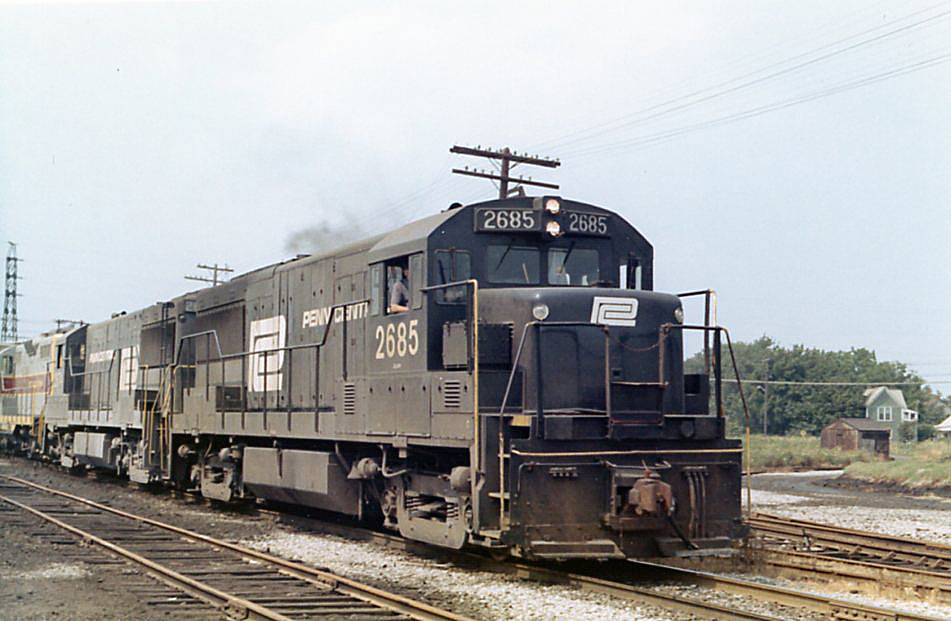 Penn Central U25Bs #2685 and #2674 lead a southbound Erie Lackawanna freight through North Tonawanda, New York on August 5, 1973. Doug Kroll photo.
Penn Central U25Bs #2685 and #2674 lead a southbound Erie Lackawanna freight through North Tonawanda, New York on August 5, 1973. Doug Kroll photo.
In his book, "Rock Island Requiem," author Gregory Schneider highlights how bad the issue became during the Penn Central bankruptcy hearings. Until deregulation the industry was not a true free market, everything (including any potential line abandonment) was controlled through the ICC.
Before Penn Central was folded into Conrail, Federal Railroad Administrator John Ingram highlighted the difficulty for any railroad to abandon an unprofitable branch. While touring the former Pennsylvania Railroad's Delmarva Peninsula trackage he said this during a speech highlighting the PC's plight:
"Let me tell you a little story about the abandonment of unprofitable branch lines. One weekend last summer I was headed for Rehoboth Beach, Delaware, to enjoy the Atlantic Ocean.
You have to drive across the Eastern Shore of Maryland to get there, and I asked my staff to list a few of those Eastern Shore branch lines that the Penn Central wants to abandon.
I wanted to see for myself - perhaps count the boxcars on sidings to see if there really was a shortage of business. I drove to the area, checked my maps, and simplycouldn't find anything that looked like a railroad.
On Monday morning, I hollered at my staff for having sent me off on a wild goose chase, but they stuck to their guns. So we went back - this time with property maps and a surveyor.
We found the branch line, all right. At one place it was directly under a junkyard full of wrecked cars. At another point the highway department had covered the tracks with at least eight inches of pavement.
And just off the road we found a six-inch wide tree growing between the rails. That line had been completely forgotten, yet grown men were arguing before the ICC that that stretch of track was vital to the Nation's economy!"
 Erie Lackawanna F7A #6361 and an F3B lead a westbound general manifest into Binghamton, New York during January of 1963. Author's collection.
Erie Lackawanna F7A #6361 and an F3B lead a westbound general manifest into Binghamton, New York during January of 1963. Author's collection.
Railroads of today would likely be very different if it wasn't for the Staggers Rail Act of 1980, proposed by Harley Staggers of West Virginia. Prior to this legislation there had been discussions of simply nationalizing the entire industry, a scary proposition that both executives and those in the government wished to avoid.
The bill brought a great level of deregulation as railroads regained their footing thanks to renewed freedom in setting freight rates and abandoning unprofitable rail lines.
The 1980s saw a slow recovery as Conrail posted its first profits in late 1981 and the mega-merger movement continued, creating today's Norfolk Southern Railway and CSX Transportation that decade. I
n the 1990's the trend continued as the Atchison, Topeka & Santa Fe Railway and Burlington Northern merged to form the Burlington Northern Santa Fe Railway in 1995.
Also, Union Pacific purchased the Chicago & North Western while Norfolk Southern and CSX gobbled up Conrail in 1999. The freight growth has continued into the 21st century. We have also seen a renaissance in rail travel as folks look to escape the highway gridlock.
- Home ›
- Rail History
Important Facts about the Invention of the Reailroad
Source: https://www.american-rails.com/history.html

0 Response to "Important Facts about the Invention of the Reailroad"
Post a Comment